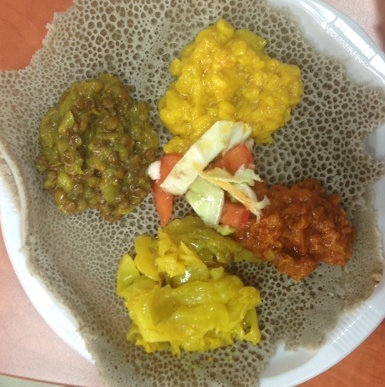First Day Back. First Taste of Ethiopian Cuisine.
- Diane Samuels
 It has been three years since I last was a volunteer at the Ethiopian National Project! Back in 2010, I was on a year-long study abroad program in Israel and decided to spend my Spring semester interning at ENP, where I learned about the rich culture and story of Ethiopians living in Israel. I am now a graduate student, studying in Jerusalem, and am very excited to start volunteering again for ENP.
It has been three years since I last was a volunteer at the Ethiopian National Project! Back in 2010, I was on a year-long study abroad program in Israel and decided to spend my Spring semester interning at ENP, where I learned about the rich culture and story of Ethiopians living in Israel. I am now a graduate student, studying in Jerusalem, and am very excited to start volunteering again for ENP.
Injera is a national dish in Ethiopia and eaten daily in almost every household. It is a flat bread with a spongy texture and a distinct sour-dough like taste and is made out of teff, a grain unique to Ethiopia. During the mealtime, injera serves as both a plate and utensils. We placed the different spiced vegetable stews in clusters (wat) on top of the injera and then tore off small pieces to then pick up bites the different vegetables to eat. The wat are the different types of stews that usually begin with chopped red onion, which is simmered or sautéed in a pot. Afterward, niter kibbeh (or vegetable oil in vegetarian dishes) and berbere, an Ethiopian spice, are added to give the dish its distinctive flavor. Niter kibbeh is a seasoned, clarified butter, while berbere is a mixture that includes powdered chili peppers and other spices. During my research, I also found out that Ethiopians eat exclusively with their right hands – as I had not known this earlier, I ate with both of my hands.
Hopefully, this short glimpse into the world of traditional Ethiopian food will inspire those of you who have yet to taste it to try something new and learn more about a new culture in the best way possible – eating! And if you are so ambitious, you can even try to hunt down some of the traditional spices that give Ethiopian food its distinct taste and cook it for yourself or for friends.
 It has been three years since I last was a volunteer at the Ethiopian National Project! Back in 2010, I was on a year-long study abroad program in Israel and decided to spend my Spring semester interning at ENP, where I learned about the rich culture and story of Ethiopians living in Israel. I am now a graduate student, studying in Jerusalem, and am very excited to start volunteering again for ENP.
It has been three years since I last was a volunteer at the Ethiopian National Project! Back in 2010, I was on a year-long study abroad program in Israel and decided to spend my Spring semester interning at ENP, where I learned about the rich culture and story of Ethiopians living in Israel. I am now a graduate student, studying in Jerusalem, and am very excited to start volunteering again for ENP.
Not only was today my first day back at ENP, but it was the first time that I have ever tried Ethiopian food (and I recommend trying it to those who have not yet tasted it!) At the ENP office, we ordered two vegetarian plates that came with injera. The food was delicious and after eating I was interested in researching more about the kinds of traditional foods eaten in Ethiopia.
Injera is a national dish in Ethiopia and eaten daily in almost every household. It is a flat bread with a spongy texture and a distinct sour-dough like taste and is made out of teff, a grain unique to Ethiopia. During the mealtime, injera serves as both a plate and utensils. We placed the different spiced vegetable stews in clusters (wat) on top of the injera and then tore off small pieces to then pick up bites the different vegetables to eat. The wat are the different types of stews that usually begin with chopped red onion, which is simmered or sautéed in a pot. Afterward, niter kibbeh (or vegetable oil in vegetarian dishes) and berbere, an Ethiopian spice, are added to give the dish its distinctive flavor. Niter kibbeh is a seasoned, clarified butter, while berbere is a mixture that includes powdered chili peppers and other spices. During my research, I also found out that Ethiopians eat exclusively with their right hands – as I had not known this earlier, I ate with both of my hands.
Hopefully, this short glimpse into the world of traditional Ethiopian food will inspire those of you who have yet to taste it to try something new and learn more about a new culture in the best way possible – eating! And if you are so ambitious, you can even try to hunt down some of the traditional spices that give Ethiopian food its distinct taste and cook it for yourself or for friends.
I would also highly recommend anyone that haven't had a chance to try Ethiopian food. There are even plenty delicious vegetarian options. http://www.easyethiopiatravel.com/traditional-ethiopianfood.shtml
ReplyDelete